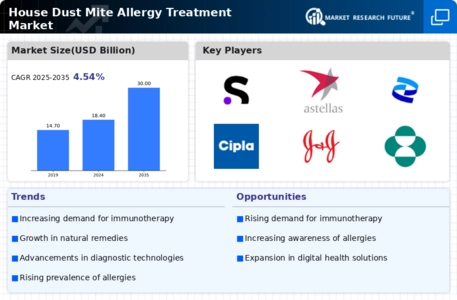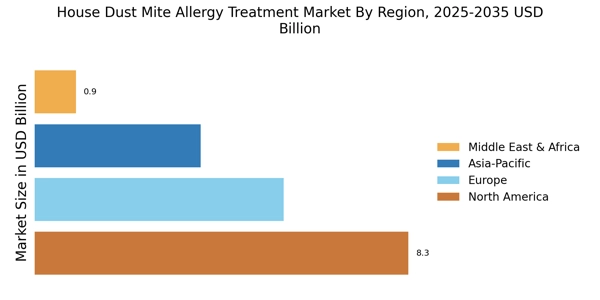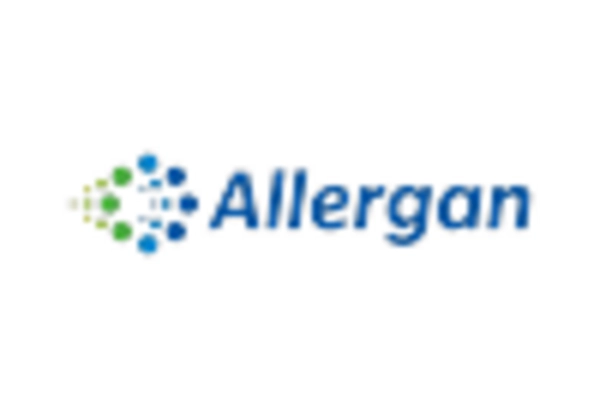Expansion of Healthcare Access
The expansion of healthcare access is a pivotal driver in the House Dust Mite Allergy Treatment Market. As healthcare systems evolve, more individuals are gaining access to allergy testing and treatment services. This expansion is facilitated by policy changes, increased insurance coverage for allergy treatments, and the proliferation of telehealth services. Consequently, patients are more likely to seek diagnosis and treatment for house dust mite allergies, leading to a surge in market demand. Data suggests that regions with improved healthcare access experience higher rates of allergy management, indicating a direct correlation between access and treatment uptake. This trend is expected to continue, further propelling the growth of the market as more individuals seek effective solutions for their allergy-related issues.
Growing Awareness of Allergies
The increasing awareness of allergies, particularly house dust mite allergies, is a notable driver in the House Dust Mite Allergy Treatment Market. As more individuals recognize the symptoms and impacts of these allergies, there is a corresponding rise in demand for effective treatment options. Educational campaigns and healthcare initiatives have contributed to this awareness, leading to a greater number of allergy tests being conducted. Reports indicate that the prevalence of allergic rhinitis, often triggered by dust mites, affects a significant portion of the population, prompting healthcare providers to recommend various treatment modalities. This heightened awareness not only drives demand for traditional medications but also encourages exploration of alternative therapies, thereby expanding the market landscape.
Advancements in Treatment Technologies
Technological advancements play a crucial role in shaping the House Dust Mite Allergy Treatment Market. Innovations in treatment methodologies, such as the development of sublingual immunotherapy and advanced allergy medications, have enhanced the efficacy and safety of allergy treatments. The integration of digital health solutions, including mobile applications for symptom tracking and telemedicine consultations, has further streamlined patient access to care. Market data suggests that the introduction of these technologies has led to increased patient adherence to treatment regimens, as they provide more personalized and convenient options. As technology continues to evolve, it is likely to drive further growth in the market, offering new avenues for effective management of house dust mite allergies.
Rising Incidence of Allergic Conditions
The rising incidence of allergic conditions, particularly those related to house dust mites, is a significant driver in the House Dust Mite Allergy Treatment Market. Epidemiological studies indicate that the prevalence of asthma and allergic rhinitis has been on the rise, with dust mites being a primary allergen. This trend is particularly evident in urban areas where environmental factors contribute to higher allergen exposure. As more individuals seek relief from allergy symptoms, the demand for effective treatment options increases. Market analysis reveals that the treatment segment for house dust mite allergies is expected to grow substantially, driven by the need for both pharmacological and non-pharmacological interventions. This growing patient population presents opportunities for healthcare providers and pharmaceutical companies to innovate and expand their offerings.
Increased Focus on Preventive Healthcare
The increased focus on preventive healthcare is influencing the House Dust Mite Allergy Treatment Market. As healthcare systems shift towards preventive measures, there is a growing emphasis on managing allergies before they escalate into more severe conditions. This proactive approach encourages individuals to seek early diagnosis and treatment for house dust mite allergies. Preventive strategies, including allergen avoidance and the use of air purifiers, are gaining traction among consumers. Market data indicates that the preventive segment is likely to see significant growth, as more people invest in products and services aimed at reducing allergen exposure. This trend not only benefits patients but also creates opportunities for businesses to develop innovative solutions tailored to allergy prevention.


















Leave a Comment